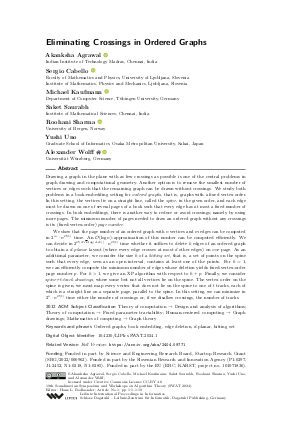@InProceedings{agrawal_et_al:LIPIcs.SWAT.2024.1,
author = {Agrawal, Akanksha and Cabello, Sergio and Kaufmann, Michael and Saurabh, Saket and Sharma, Roohani and Uno, Yushi and Wolff, Alexander},
title = {{Eliminating Crossings in Ordered Graphs}},
booktitle = {19th Scandinavian Symposium and Workshops on Algorithm Theory (SWAT 2024)},
pages = {1:1--1:19},
series = {Leibniz International Proceedings in Informatics (LIPIcs)},
ISBN = {978-3-95977-318-8},
ISSN = {1868-8969},
year = {2024},
volume = {294},
editor = {Bodlaender, Hans L.},
publisher = {Schloss Dagstuhl -- Leibniz-Zentrum f{\"u}r Informatik},
address = {Dagstuhl, Germany},
URL = {https://drops.dagstuhl.de/entities/document/10.4230/LIPIcs.SWAT.2024.1},
URN = {urn:nbn:de:0030-drops-200417},
doi = {10.4230/LIPIcs.SWAT.2024.1},
annote = {Keywords: Ordered graphs, book embedding, edge deletion, d-planar, hitting set}
}

 Creative Commons Attribution 4.0 International license
Creative Commons Attribution 4.0 International license

